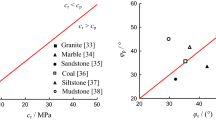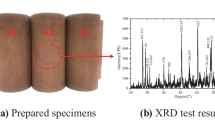Abstract
Experimental results provide strong evidence that the deformation and strength of rocks are closely related to the damage suffered during loading. The classic constitutive models such as Mohr–Coulomb criterion and the Drucker–Prager criterion are usually unable to describe the non-linear deformation behavior of rocks, including strain hardening and softening. Their applications in numerical analysis and practical engineering are limited. For this purpose, an elastoplastic damage constitutive model that takes into account the competition mechanism between damage and strain hardening or softening during rock compression is proposed herein. This model is used to investigate the deformation behaviors and damage evolution of rocks. More importantly, this model has been implemented by finite element programming code and verified by a series of triaxial compression tests. The comparison results between theoretical analysis and experimental data indicate that this model can well describe the stress–strain curves and damage–strain curves of the investigated rocks (sandstone and salt rock), especially the characteristics of softening, hardening and residual strength. Based on parametric analysis, the influence of confining pressure, scale parameter and shape parameter on rock damage is revealed. It is found that the rock scale parameter in this model has a power function relationship with confining pressure. The ultimate plastic deformation that rocks can withstand is related to the scale parameter. The shape parameter controls the residual strength and deformation of rocks. Model results demonstrate that the strength and deformation vary with rock properties, and are strongly dependent on the stress-induced damage and strain characteristics.














Similar content being viewed by others
Data availability
No associated data or the data will not be deposited.
References
Ashby M, Sammis C (1990) The damage mechanics of brittle solids in compression. Pure Appl Geophys 133(3):489–521. https://doi.org/10.1007/BF00878002
Bai Y, **a M, Ke F, Li H (2001) Statistical microdamage mechanics and damage field evolution. Theor Appl Fract Mech 37(1–3):1–10. https://doi.org/10.1016/S0167-8442(01)00087-8
Cao Y Y, Ma S P, Wang X, Hong Z Y (2011) A new definition of damage variable for rock material based on the spatial characteristics of deformation fields. Advanced Materials Research. Trans Tech Publ, pp. 865-868. https://doi.org/10.4028/www.scientific.net/AMR.146-147.865
Chan K, Bodner S, Fossum A, Munson D (1997) A damage mechanics treatment of creep failure in rock salt. Int J Damage Mech 6(2):121–152. https://doi.org/10.1177/105678959700600201
Chang S-H, Lee C-I (2004) Estimation of cracking and damage mechanisms in rock under triaxial compression by moment tensor analysis of acoustic emission. Int J Rock Mech Min Sci 41(7):1069–1086. https://doi.org/10.1016/j.ijrmms.2004.04.006
Chen L, Wang C, Liu J, Liu J, Wang J, Jia Y, Shao J (2015) Damage and plastic deformation modeling of Beishan granite under compressive stress conditions. Rock Mech Rock Eng 48(4):1623–1633. https://doi.org/10.1007/s00603-014-0650-5
Chen X, Li Y, Shi Y, Yu Y, Jiang Y, Liu Y, Dong J (2021) Tightness and stability evaluation of salt cavern underground storage with a new fluid–solid coupling seepage model. J Pet Sci Eng 202:108475. https://doi.org/10.1016/j.petrol.2021.108475
Deng J, Gu D (2011) On a statistical damage constitutive model for rock materials. Comput Geosci 37(2):122–128. https://doi.org/10.1016/j.cageo.2010.05.018
Eberhardt E (2012) The hoek–brown failure criterion. The ISRM Suggested Methods for Rock Characterization, Testing and Monitoring: 2007–2014. Springer, Cham, pp. 233–240.
Fan L, Liu S (2017) A conceptual model to characterize and model compaction behavior and permeability evolution of broken rock mass in coal mine gobs. Int J Coal Geol 172:60–70. https://doi.org/10.1016/j.coal.2017.01.017
Ge X, Ren J, Pu Y, Ma W, Zhu Y (2001) Real-in time CT test of the rock meso-damage propagation law. Sci China Ser E: Technol Sci 44(3):328–336. https://doi.org/10.1007/BF02916710
Jiang X, Shu-chun L, Yun-qi T, **ao-jun T, **n W (2009) Acoustic emission characteristic during rock fatigue damage and failure. Procedia Earth Planetary Sci 1(1):556–559. https://doi.org/10.1016/j.proeps.2009.09.088
Kachanov L (1986) Introduction to continuum damage mechanics. Springer Science & Business Media, Springer, Netherlands, Dordrecht, pp 4–12
Lemaitre J (1984) How to use damage mechanics. Nuclear Eng Design 80(2):233–245. https://doi.org/10.1016/0029-5493(84)90169-9
Lemaitre J, Desmorat R (2006) Engineering damage mechanics: ductile, creep, fatigue and brittle failures. Springer Science & Business Media, France, pp 1–7
Li X, Cao W-G, Su Y-H (2012) A statistical damage constitutive model for softening behavior of rocks. Eng Geol 143:1–17. https://doi.org/10.1016/j.enggeo.2012.05.005
Li H, Dong Z, Ouyang Z, Liu B, Yuan W, Yin H (2019) Experimental investigation on the deformability, ultrasonic wave propagation, and acoustic emission of rock salt under triaxial compression. Appl Sci 9(4):635. https://doi.org/10.3390/app9040635
Liu H, Yuan X (2015) A damage constitutive model for rock mass with persistent joints considering joint shear strength. Can Geotech J 52(8):1136–1143. https://doi.org/10.1139/cgj-2014-0252
Liu X, Ning J, Tan Y, Gu Q (2016) Damage constitutive model based on energy dissipation for intact rock subjected to cyclic loading. Int J Rock Mech Mining Sci 85:27–32. https://doi.org/10.1016/j.ijrmms.2016.03.003
Lubarda VA (2001) Elastoplasticity theory. CRC Press, New York, pp 184–205
Moghadam SN, Mirzabozorg H, Noorzad A (2013) Modeling time-dependent behavior of gas caverns in rock salt considering creep, dilatancy and failure. Tunnel Underground Space Technol 33:171–185. https://doi.org/10.1016/j.tust.2012.10.001
Salari M, Saeb S, a, Willam K, Patchet S, Carrasco R, (2004) A coupled elastoplastic damage model for geomaterials. Comput Methods Appl Mech Eng 193(27–29):2625–2643. https://doi.org/10.1016/j.cma.2003.11.013
Shao J-F, Jia Y, Kondo D, Chiarelli A-S (2006) A coupled elastoplastic damage model for semi-brittle materials and extension to unsaturated conditions. Mech Mater 38(3):218–232. https://doi.org/10.1016/j.mechmat.2005.07.002
Shen P, Tang H, Ning Y, **a D (2019) A damage mechanics based on the constitutive model for strain-softening rocks. Eng Fract Mech 216:106521. https://doi.org/10.1016/j.engfracmech.2019.106521
Singh M, Raj A, Singh B (2011) Modified Mohr-Coulomb criterion for non-linear triaxial and polyaxial strength of intact rocks. Int J Rock Mech Mining Sci 48(4):546–555. https://doi.org/10.1016/j.ijrmms.2011.02.004
Tang C, Kaiser P (1998) Numerical simulation of cumulative damage and seismic energy release during brittle rock failure—part I: fundamentals. Int J Rock Mech Min Sci 35(2):113–121. https://doi.org/10.1016/S0148-9062(97)00009-0
Unteregger D, Fuchs B, Hofstetter G (2015) A damage plasticity model for different types of intact rock. Int J Rock Mech Min Sci 80:402–411. https://doi.org/10.1016/j.ijrmms.2015.09.012
Wang J, Song Z, Zhao B, Liu X, Liu J, Lai J (2018) A study on the mechanical behavior and statistical damage constitutive model of sandstone. Arabian J Sci Eng 43(10):5179–5192. https://doi.org/10.1007/s13369-017-3016-y
Wang C, He B, Hou X, Li J, Liu L (2020a) Stress–energy mechanism for rock failure evolution based on damage mechanics in hard rock. Rock Mech Rock Eng 53(3):1021–1037. https://doi.org/10.1007/s00603-019-01953-y
Wang J, Zhang Q, Song Z, Zhang Y (2020b) Creep properties and damage constitutive model of salt rock under uniaxial compression. Int J Damage Mech 29(6):902–922. https://doi.org/10.1177/1056789519891768
Weibull W (1951) A statistical distribution function of wide applicability. J Appl Mech 18(3):293–297
Wong T-f, Baud P (2012) The brittle-ductile transition in porous rock: a review. J Struct Geol 44:25–53. https://doi.org/10.1016/j.jsg.2012.07.010
Wu F, Chen J, Zou Q (2019) A nonlinear creep damage model for salt rock. Int J Damage Mech 28(5):758–771. https://doi.org/10.1177/1056789518792649
**e H, He C (2004) Study of the unloading characteristics of a rock mass using the triaxial test and damage mechanics. Int J Rock Mech Min Sci 41:74–80. https://doi.org/10.1016/j.ijrmms.2004.03.022
Yang S-Q, Xu P, Ranjith P (2015) Damage model of coal under creep and triaxial compression. Int J Rock Mech Min Sci 80:337–345. https://doi.org/10.1016/j.ijrmms.2015.10.006
Yang Y, Ma D, He Y, **ng L (2014) Study on Test Method of Rock Acoustic Emission and Damage Evolution Characteristics Under Triaxial Compression. Taishan Academic Forum–Project on Mine Disaster Prevention and Control. Atlantis Press, pp. 321–326.
Zhang Q, Shuilin W, **urun G, Hongying W (2010) Modified Mohr-Coulomb strength criterion considering rock mass intrinsic material strength factorization. Mining Sci Technol 20(5):701–706. https://doi.org/10.1016/S1674-5264(09)60266-0
Zhang J, Xu W, Wang H, Wang R, Meng Q, Du S (2016) A coupled elastoplastic damage model for brittle rocks and its application in modelling underground excavation. Int J Rock Mech Min Sci 84:130–141. https://doi.org/10.1016/j.ijrmms.2015.11.011
Zhao L-y, Zhang W-l, Lai Y-m, Niu F-j, Zhu Q-z, Shao J-f (2021a) A Heuristic elastoplastic damage constitutive modeling method for geomaterials: from strength criterion to analytical full-spectrum stress-strain curves. Int J Geomech 21(2):04020255. https://doi.org/10.1061/(ASCE)GM.1943-5622.0001902
Zhao Y, Liu Q, Zhang C, Liao J, Lin H, Wang Y (2021b) Coupled seepage-damage effect in fractured rock masses: model development and a case study. Int J Rock Mech Min Sci 144:104822. https://doi.org/10.1016/j.ijrmms.2021.104822
Zhou H, Jia Y, Shao J-F (2008) A unified elastic–plastic and viscoplastic damage model for quasi-brittle rocks. Int J Rock Mech Min Sci 45(8):1237–1251. https://doi.org/10.1016/j.ijrmms.2008.01.004
Acknowledgements
The authors wish to acknowledge the financial supports from the National Natural Science Foundation of China (Grant No. 52208342, 52168049), Jiangxi Provincial Natural Science Foundation (Grant No. 20212BAB214009), the Open Project of State Key Laboratory of Geomechanics and Geotechnical Engineering, Institute of Rock and Soil Mechanics, Chinese Academy of Sciences (Grant No. Z020016). The authors are sincerely grateful to Jaak J Daemen, Mackay School of Earth Sciences and Engineering, University of Nevada, for his thoughtful proofreading of this paper.
Author information
Authors and Affiliations
Additional information
Publisher's Note
Springer Nature remains neutral with regard to jurisdictional claims in published maps and institutional affiliations.
Rights and permissions
Springer Nature or its licensor (e.g. a society or other partner) holds exclusive rights to this article under a publishing agreement with the author(s) or other rightsholder(s); author self-archiving of the accepted manuscript version of this article is solely governed by the terms of such publishing agreement and applicable law.
About this article
Cite this article
Chen, X., Li, Y., Tong, L. et al. Elastoplastic Damage Behavior of Rocks: A Case Study of Sandstone and Salt Rock. Rock Mech Rock Eng 56, 5621–5634 (2023). https://doi.org/10.1007/s00603-023-03349-5
Received:
Accepted:
Published:
Issue Date:
DOI: https://doi.org/10.1007/s00603-023-03349-5




